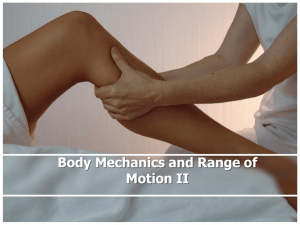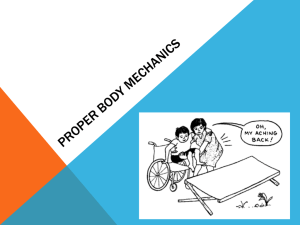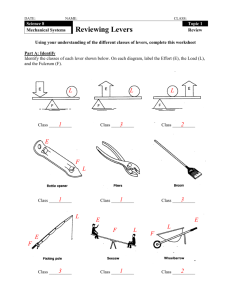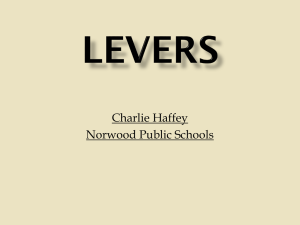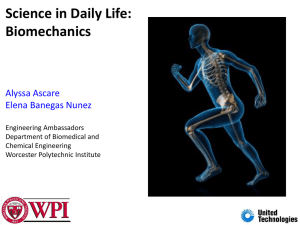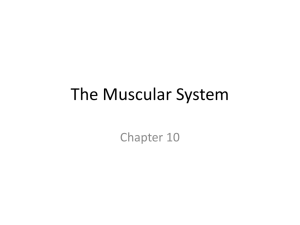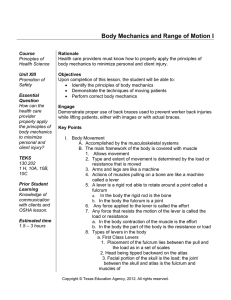Body Mechanics and Range of Motion
advertisement
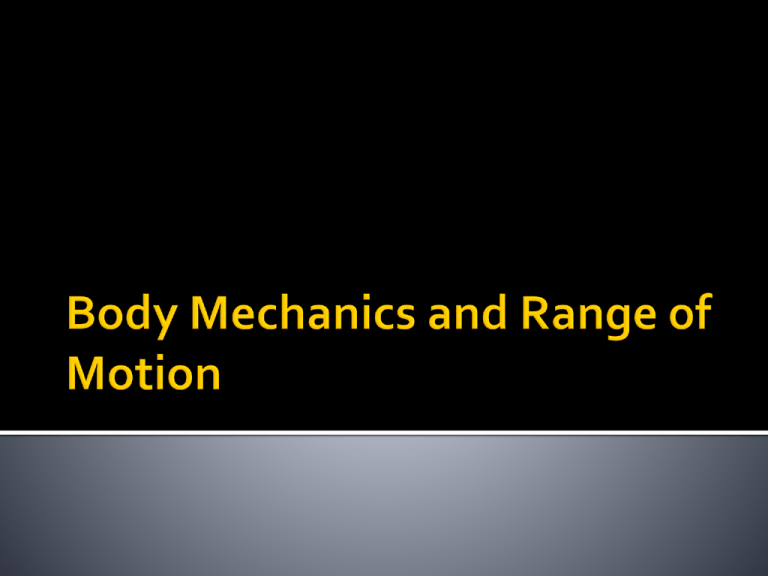
Accomplished by the musculoskeletal systems The main framework of the body is covered with muscle 1. Allows movement 2. Type and extent of movement is determined by the load or resistance that is moved 3. Arms and legs are like a machine 4. Actions of muscles pulling on a bone are like a machine called a lever 5. A lever is a rigid rod able to rotate around a point called a fulcrum ▪ a. In the body the rigid rod is the bone ▪ b. In the body the fulcrum is a joint 6. Any force applied to the lever is called the effort 7. Any force that resists the motion of the lever is called the load or resistance ▪ a. In the body contraction of the muscle is the effort ▪ b. In the body the part of the body is the resistance or load First Class Levers 1. Placement of the fulcrum lies between the pull and the load as in a set of scales 2. Head being tipped backward on the atlas 3. Facial portion of the skull is the load; the joint between the skull and atlas is the fulcrum and muscles of the back produce the pull Second Class Levers 1. The load lies between the fulcrum and the joint at which the pull is exerted 2. Raising of the body on the toes 3. Point of contact between the toes and the ground is the fulcrum, load is located at the ankle and the pull is exerted by the gastrocnemius (the muscle in the calf) Third Class levers 1. Pull is exerted between the fulcrum and resistance or load to be moved 2. Flexing of the forearm at the elbow joint as in lifting a hand weight 3. Load is the weight in the hand, the pull is the biceps brachii muscle and the fulcrum is the elbow Proper Posture -position of body parts in relation to each other Body Mechanics -using all body parts efficiently and in a careful way Having proper posture and body mechanics is necessary in to order to limit stress and strain on the musculoskeletal system a. Lifting, pushing or pulling increases stresses on musculoskeletal system Use the larger and stronger muscles to perform work (shoulders, upper arms, hip and thighs) Maintain the center of gravity of the body close to the center of the base of support (feet provide a base of support for humans) Keep the combined center of gravity of the Health Care worker and the object or person to be moved centered within the base of support (hold objects to be moved close to you) Have a base of support that is the appropriate size and shape Use stronger, larger muscles to perform tasks which require physical effort When moving a heavy object, try to push or pull instead of lifting the item Maintain a wide base of support (feet approximately 12 inches apart) Get help if object feels too heavy to lift Lift in a smooth motion to prevent injury Maintain good posture Avoid twisting the body; turn your whole body ; face the area in which you are working Bend knees, keep back straight, spread feet about one foot apart, us leg muscles when lifting Keep objects close to your body when lifting, moving or carrying them Avoid unnecessary bending and reaching: raise bed or overbed tab to your waist level At all times, that you have to lift, move or carry an item 1. In everyday daily activities, e.g. cleaning, carrying books to school and to class, getting in and out of a car 2. In Health Care setting, e.g. when assisting a patient to a chair, when picking up supplies, when positioning a patient in bed. Ergonomics: The science of work. The science of fitting the work to the user instead of forcing the user to fit the work. (OSHA has put emphasis on developing a policy of no lifting in Long Term Care Facilities and other high risk areas.) Range of Motion: the complete extent of movement of which a joint is capable Used when doing routine activities such as bathing eating and dressing; uses muscles that keep many joints in effective range of motion To prevent problems caused by a lack of movement To prevent problems caused by inactivity 1.contractures: a tightening and shortening of a muscle e.g. footdrop 2.Muscles may atrophy (shrink) when they are not used 3.Joints become stiff 4. Blood clots and decubitus ulcers may develop Active Range of Motion (AROM): movements performed by the patient without help Passive Range of Motion (PROM): movement cannot be performed by the patient and the health care worker moves each joint through its range of motion Active assistive Range of Motion (AAROM): the patient does the exercises with some assistance from another person Use good body mechanics; raise the bed to your waist level if the patient is in bed Expose only the body part being exercised Explain to the patient what you are going to do and teach the patient how to do them Support the extremity being exercised (place hands under the extremity supporting the joint above and the joint below the one you are exercising) Move each joint until there is resistance but not pain Move each joint slowly, smoothly and gently Return the joint to a neutral position after the movement Keep friction to a minimum so that Repeat each exercise 3-5 times Abduction: moving a body part away from the midline Adduction: moving a body part toward the midline Flexion: bending a body part Extension: straightening a body part Hyperextension: excessive straightening of a body part Rotation: moving in a circle at a joint Pronation: turning a body part downward Supination: turning a body part upward Inversion: turning a body part inward Eversion: turning a body part outward Dorsiflexion: bending backward Plantar Flexion: bending forward Radial deviation: moving toward the thumb side Ulnar deviation: moving toward the little finger side
